[Section 6, Page 4] J. E. E. Markley was prominent in the legal and business life of Mason City for
a half century. He served as president of the Iowa State Bar Association and was a member of the American Law
Institute, a leader in the movement for law reform and an active participant in early Iowa activities of the
Democratic party. He came to Mason City in 1881 from Marshalltown and died in 1939 at the age of 82 years.
NOTE: James E. E. Markley was born in 1857, and died in 1939. Lillian E. Markley was born in
1869, and died in 1932. They were interred at Elmwood-St. Joseph Cemetery.
James E. E. Markley and James E.
Blythe, partners in their prominent Mason City law firm, awarded a commission to Frank Lloyd Wright for the purpose
to complete a quality building across the street from a competitive bank. The result was Wright's first
building in Iowa - Mason City's famed Park Inn and Hotel. Markley and Blythe located their firm on the second floor
of the building's narrower central waist and the hotel's east wing. Their law office opened in its new location on
August 29, 1910; the entire building was opened the following September 10th.
* * * * * * * * * * * * * * * * * * * * * * * * *
1934: BANDIT STOLE SHOW FROM HUTCHINS
 [Section 6, Page 4] Dr. Robert Maynard Hutchins continues to remember an address he gave in the
Mason City armory the night of March 13, 1934.
[Section 6, Page 4] Dr. Robert Maynard Hutchins continues to remember an address he gave in the
Mason City armory the night of March 13, 1934.
At that time as the "boy wonder" president of the University of Chicago,
he was in growing demand as a speaker on educational methods. But that day even Dr. Hutchins made a small impression on
Mason City. Another individual with no scholastic degrees had stolen the show. That was the day Dillinger robbed
the First National Bank.
Dillinger not only stole the show from the great educator, but continued to be one of the
big news sources until he met a violent death on July 23.
Watched Crime FilmThat night
Dillinger and his companions - one of them a woman in a red dress - watched William Powell in a crime picture called
"Manhattan Melodrama" in a Chicago theater. Meanwhile 17 armed men gathered in the street outside.
When the gangster
came out, plainly marked in the crowd by the flame colored dress beside him, they spotted him at once and tried to close
in.
Dillinger reached for a gun but the federal agents and the Chicago policemen fired first. Three bullets hit, one of
them crashing through his head. He reeled away, staggered 100 feet, fell and died in an alley.
The next morning a
coroner's jury briskly wound up an ugly era in American history with this verdict:
"Justifiable homicide by officers
of the federal government."
While the man who stole the day from him in Mason City passed on, Dr. Hutchins continued
to increase his influence on the American education system and in a short time ago, together with Mortimer
Adler, brought out the "Great Books of the Western World," containing all the accumulated wisdom of the western world over
the past 3,000 years. Last fall the Mason City Lions Club gave a copy of this great set to the Mason City Library.
There's a moral somewhere in the story of these men, acknowledged top figures in their respective fields - Hutchins
vs. Dillinger.
* * * * * * * * * * * * * * * * * * * * * * * * *
1935: SPRAGUE TAKES OVER M.&St.L.
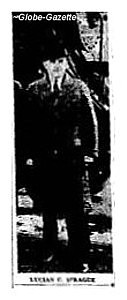 [Section 6, Page 6] It could only have happened in America. Forty-two times the Minneapolis & St.
Louis [Railroad] was put up for sale and each time there were no bidders. Then came the 43rd attempt - and L. C.
[Lucian C.] Sprague.
[Section 6, Page 6] It could only have happened in America. Forty-two times the Minneapolis & St.
Louis [Railroad] was put up for sale and each time there were no bidders. Then came the 43rd attempt - and L. C.
[Lucian C.] Sprague.
That was in 1932 when the country was still deep in the Great Depression. In January, 1935, Sprague took over
the railroad. The story of what Sprage did with this railroad, which was about to be dismembered, is one of the great
epics of American initiative and a sago of industrial development.
Mason City and other North Iowa points were a part
of this drama, which is depicted so graphically in the book, "Mileposts of the Prairie," by Frank P. Donavan, Jr.
Mason City's first contact with the railroad was in 1871 when the segment of what was later to become a 1,400 mile system
was built northward from Eldora, where coal had been found, and called the Central Railroad of Iowa.
Organized in MinneapolisThe M. and St. L. was organized in Minneapolis to provide the city with an
outlet to the south and east. By Nov. 12, 1877, the road reached Albert Lea and a year later in conjunction with the
Burlington, Cedar Rapids and Northern (now the Rock Island) the Iowa border.
In 1888 the Central Iowa was foreclosed
and under reorganization took the name of the Iowa Central, which name it retained until it was joined with the M. and
St. L.
The drubbing taken by the M. and St. L. during World War I and crop failures in South Dakota brought the road
into receivership in 1923. Sprague was named receiver and president of the road upon the death of William H. Bremner in 1934
and was given an opportunity by the bondholders to rehabilitate the railroad. He started work in January, 1935.
Visited Mason CitySprague, who visited Mason City several times in his efforts to rejuvenate
the railroad, had begun his career as callboy on the Burlington. From the "Q" he went into engineering and supervisory
positions with the Great Northern, Baltimore & Ohio, and Denver & Rio Grande Western.
Meeting the payroll with nearly
an empty till was his No. 1 job on the M. & St. L. Many expressed the opinion that the road was "of little worth as a railroad
but of considerable junk value." That was his cue. He raised $60,000 in a couple of days by contacting a friend in the
wrecking business. A thousand obsolete freight cars rotting in the yards had given him an idea.
Gets
Face LiftingFrom that time on the M. & St. L. started on the long road to complete rehabilitation. All
along the line a general face-lifting became noticeable. One hundred pound rails took the place of lighter steel on the
main line, and crushed rock ballast replaced slag and cinders.
The steam engine which had been the only type of
locomotive on the road shared a place with the Diesel. The advent of "road" Diesels meant faster and more economical
freight operation. When Sprague came to the road the fastest freights tool 32 1/2 hours to make the 476 mile run from
Minneapolis to Peoria. Now the "three units" barrel from terminal to terminal in 17 hours and 55 minutes.
In
December, 1943, the M. & St. L. emerged from a 20 year receivership with the same name except that "railway" replaced
"railroad" in the title. The receivership was the longest of any Class I railroad still running in America.
NOTE: Lucian C. Sprague died of a heart attack at the age of 78 years August 3, 1960, on in Minneapolis.
Born in Senrena, Illinois, he took over as receiver of the M. & St. L. Railway in 1935 and became president in 1943.
His success in nursing the M. & St. L. back to health earned him the title of "doctor of sick railroads."
He left this job in 1954 to become a financial consultant for numerous firms. Ben W. Heineman of Chicago gained
control of the railroad after Sprague stepped down.
SOURCE: Globe-Gazette, Thursday, August 4,
1960, p. 4.; Thursday, August 11, 1960, p. 11.
* * * * * * * * * * * * * * * * * * * * * * * * *
REHABILITATING A RAILROAD
[Section 6, Page 6] This picture presents something of Mason City's part in the rehabilitation of the
M. and St. L. railroad. It was taken at the railroad station here in November, 1939, at the time L. C. Sprague,
president of the M. and St. L., and other officers of the road were given a welcome by Mason City business men.
From left are H. W. Ward, general traffic manager, Minneapolis; B. A. MacDonald, vice president and general
manager of the Northwestern States Portland Cement Company here; Charles E. Strickland, president of the People's
Gas and Electric company and head of another railroad, the Mason City and Clear Lake; President Sprague, the
late Fred Duffield, president of the Chamber of Commerce; and W. H. Rees, treasurer of the Mason City Brick
and Tile Company.
* * * * * * * * * * * * * * * * * * * * * * * * *
M. AND ST. L. SYSTEM
[Section 6, Page 6] The map shows how the M. and St. L. made use of a strategic position to provide a
means of moving cross country freight through the "Peoria gateway" instead of through the congested Chicago area. It
also shows how the M. and St. L. provides a direct line to St. Louis from Minneapolis by use of Wabash railroad
in Missouri.
* * * * * * * * * * * * * * * * * * * * * * * * *
1936: WORST WINTER of THIS GENERATION TIES TRAFFIC
 [Section 6, Page 6] From the middle of January to the close of February, 1936, Mason City and environs
had the worst winter weather of this generation.
[Section 6, Page 6] From the middle of January to the close of February, 1936, Mason City and environs
had the worst winter weather of this generation.
For six weeks period highways and railroad were blocked periodically,
with minimum temperatures ranging from 3 above zero to 29 below and the snowfall and wind causing the tallest drifts
in North Iowa in modern times.
The period from Jan. 20 to Feb. 19 was the coldest month ever recorded in Mason City.
On Feb. 25, 1936, Abel and Son, Inc., ran an advertisement in the Globe-Gazette that was copied throughout the
nation in railroad magazines and other publications, while at the same time bringing a stream of appreciative letters
from railroad men of all ranks from presidents to janitors. It was headed an appreciation to "Our Railroads" and voiced
the common thanks of everyone for the valiant service given by the railroads in the worst winter weather in the memory
of the present generation.
Not only railroad men, but also highway workers performed heroic deeds in the almost
futile effort to keep the highways open during a part of this period.
By this time use of highways for extensive
passenger and freight travel made necessary efficient snow removal equipment.
NOTE:
Early on the morning of Thursday, February 28, 1936, a fire gutted the Consolidated Coal and Coke Company, 115 Seventh Street S.E.,
when a blizzard blew through the area. The entire structure, three large coal trucks, two carloads of coal, considerable
feet and a large number of beer cases and barrels were destroy as the blizzard blew flames to nearby buildings and a barn.
The barn caught fire 10 times. Sparks from the fire were blown as far as the Milwaukee railroad station and
roundhouse, located several blocks away. Estimated loss was between $15,000 an d$20,000. SOURCE: The Globe-Gazette,
Thursday, February 28, 1936, p. 1
* * * * * * * * * * * * * * * * * * * * * * * * *
IN WINTER of 1936 ~ WORST in 116 YEARS
[Section 6, Page 6] During the winter of 1936, the worst in 116 years, according to records, three
complete tieups of transportation, continued sub-zero weather, acute fuel shortages in many towns, loss of much
time in schools, delays of mail for many days on rural routes and drifts as deep as 25 feet were characteristics of
the season.
The photographs were published in the Thursday, February 27th, 1936 issue the Globe-Gazette, Page 20.
Pictures of Worst North Iowa Winter for 116 Years
Snowplows Fought Record Subzero Weather and Snowdrifts on R. R. Lines and Highways
* * * * * * * * * * * * * * * * * * * * * * * * *
1937: RENWICK BUS and TRAIN CRASH KILLS 10
[Section 6, Page 6] On Friday afternoon, Oct. 22, 1937, a bus carrying 29 persons was crossing the railroad
track near Mason City Brick and Tile Company plants.
The bus was loaded with high school youngsters, instructors and
the driver, who had left Renwick in the morning for an educational tour of Mason City industries.
They had seen operations
at one of the cement plants, Jacob E. Decker and Sons, the American Crystal Sugar Company and, finally, had visited a
brick and tile plant. They were soon to be on their way home.
Struck by TrainJust as the bus
reached the tracks,a Rock Island streamliner plowed into it, killing 10 of the occupants of the bus and injuring the other
19.
Besides the driver, Rex Simpson, the death victims were Larence Morton of Guernsey and Miss Dorothy Ross of
Creston, teachers, and the following students of the Renwick Consolidated School: Patsy Turner, Albert Siemens, Lowell
Kelling, Donald Amosson, Jimmie
Bell, Norman Eggerts and Lillian Cedar.
It was the worst tragedy in Mason City's history. Its impact on the
community that was being host to those visitors was not soon forgotten.
Voiced City's Sorrow
Mayor Leo Davey voiced the feeling of Mason City citizens in a letter to Mayor Elmer Dietrich and the citizens of
Renwick and community.
"All the people of Mason City are shocked beyond expression by the terrible tragedy," wrote
Mayor Davey.
"It is beyond my power to adequately portray the grief and sorrow that we all have at this time
and I am at a loss to convey to you the sympathy that everyone in this community has for the bereaved parents and others
in your city and community.
Currie Store BurnsIt was in November, 1937, that one of the city's
most devastating fires occurred, destroying the Currie Hardware Store, which stood on the north part of the present [1953]
Eaton store site on Federal.
Adjoining buildings, including the Olympia Cafe, were badly damaged by this fire which
threatened the whole downtown section. The following year Curries opened its present [1953] modern store on East State.
* * * * * * * * * * * * * * * * * * * * * * * * *
1938: PACKINGHOUSE WORKERS UNION CERTIFIED
[Section 6, Page 8] many events made 1938 a time to be remembered. That was the year Mason City observed its 85th
anniversary. In November, 1938, the local union of the United Packinghouse Workers was certified as the first step in the
organization of a number of industries in Mason City by the Congress of Industrial Organization (CIO).
Mason City's 85th anniversary
celebration was built around the North Iowa Band Festival, then in its third year and electing a queen for the first time.
The CIO had started work here as early as 1935. On Oct. 24, 1937, the packinghouse organization committee was set up, which
not only organized the packinghouse workers, but also took an active part in organizing other industries in Mason City.
The first officers of the packing house workers union were: Edward Newman, president; Anton Anderson, vice president;
Maurice Nyvall, financial-secretary; Sherman Taylor, recording secretary; and Wayne Elliott, business agent. Organized first
as No. 451, the local's number was later changed to No. 38.
Tile Workers JoinThe brick and tile
workers became members of the CIO in February, 1944, as local 105 of the Mine, Mill and Smelter Workers International. The
officers of local 105 at that time were: Joe Walsh, president and August Hanson, vice president. In 1945 Local 105 left the
Mine, Mill and Smelter Workers and became affiliated with the Glass, Ceramic and Selica Workers of America, CIO. Recent
officers have been: Ben F. Parker, president; Oscar Spencer, recording secretary; and Martin Rybnika, financial
secretary.
In 1944 the City Employes (sic) (street, parks, sewer, garbage and water departments) were organized in
local Industrial Union No. 1267. They were the first municipal workers to be organized in Iowa. Officers at that time
were: Clarence Penny, president; John Mitchell, vice president; Jack Wuthers, recording secretary; and Charles Tooney,
financial secretary. The present officers are; Walter Buser, president; Leland Green recording secretary; and Wayne
White, secretary-treasurer.
Clothing Workers AddedIn 1948 local 568 of the Amalgamated
Clothing Workers of America-CIO was organized among the workers of Mode O'Day Corportation, manufacturers of slips,
nightgowns and other women's wear. Officers in the past have been: Madge Peterson, president; Josephine McCoun, vice
president; Arda Mae Klien, recording secretary; and Margaret Belseth, financical secretary.
Also active here is the
Cerro Gordo County Industrial Union Council-CIO. This was formed as a means of breaking down the rather closed lines of
industrial groups and to provide a means for all CIO in Cerro Gordo County, small or large, to pool their strength
for emergencies.
* * * * * * * * * * * * * * * * * * * * * * * * *
PACKINGHOUSE WORKERS UNION
[Section 6, Page 8] Axel Hull, right, third district representative of the Packinghouse Workers Union, is shown swearing
in the present officers of the Packinghouse Workers Union, Local 38.
They are, from left: Jim Foreman, trustee; Al Becker,
recording secretary; Lyle Medlin, executive member-at-large; Frank Poole, financial secretary-treasurer; Mable Haunches,
chief plant steward; John Wagner, trustee; Fred Carson, guard, and William Shannon, president.
Not shown are Leo Weitzel,
vice president; Hector Newman, trustee; and Joe Franks, sergeant-at-arms.
* * * * * * * * * * * * * * * * * * * * * * * * *
1939: ONTJES-MacNIDER TRIAL SETS DISTRICT COURT RECORD
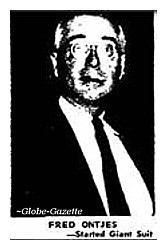 [Section 6, Page 8] After nearly eight years of legal tangles, a case involving a claim of $2,393,143 against
the estate of C. H. McNider got under way Jan. 30, 1939. The action was brought by F. A. Ontjes and other stockholders
of the Northwestern States Portland Cement Company, who filed their claim Aug. 6, 1931.
[Section 6, Page 8] After nearly eight years of legal tangles, a case involving a claim of $2,393,143 against
the estate of C. H. McNider got under way Jan. 30, 1939. The action was brought by F. A. Ontjes and other stockholders
of the Northwestern States Portland Cement Company, who filed their claim Aug. 6, 1931.
The case involved one of the
largest sums of money ever in dispute in Iowa and was one of the most intricate legal battles in the history of the state
bar.
The plaintiffs alleged that C. H. McNider, father of Gen. Hanford MacNider, as president of the Northwestern States
Portland Cement Company, failed to turn over to the corporation certain stock in another cement company purchased by him
and that he was legally paid bonuses in addition to his salary.
Three Appeals MadeBy the time
the case came to trial there had been three appeals to the Supreme Court. Every judge in the district had made at least
one ruling and some of them many. Fillings in the case consisted of thousands of pages of petitions, amendments to
substituted petitions, motions, rulings, orders and other legal papers, as well as stacks of printed briefs, pleadings
and arguments.
By the time the trial started practically everyone who participated in the events involved in the case
were dead.
The trial came to a close Aug. 30, 1939, exactly seven months after Judge Henry N. Graven (now [1953] on the
federal bench) turned to the eight attorneys and said: "You may proceed."
That day Judge Graven announced his decision,
which allowed $57,930.66 plus interest, which brought the total to $110,349.61. This award was affirmed in October by
the Iowa Supreme Court.
Many Attorneys InvolvedAttorneys for the defense in the marathon case
were Earl Smith, John Senneff and John Senneff, Jr., of Mason City, and Angus A. McLaughlin, Des Moines. Associated with
Ontjes were W. G. Henke, Charles City, Dennis Kelleher, Fort Dodge, and F. F. Faville, Sioux City.
Unfolded in the
trial was the whole story of the Northwestern States Portland Cement Company and the role taken by McNider in building up
the corporation. The Mason Cityan became identified with the company when he sold the corporation a 286 acre farm and
received in return $5,000 in stock in the company at the time the plant was built in 1907.
NOTE:
Fred Ontjes, born in 1884, died in 1975 and was interred at Oak Hill Cemetery, Parkersburg, Iowa.
* * * * * * * * * * * * * * * * * * * * * * * * *
WHEN DECISION WAS ANNOUNCED
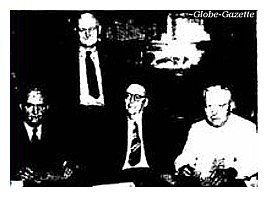
[Section 6, Page 8] Gen. Hanford MacNider, left, is shown with his attorneys at the time the judge's
decision was announced in the Ontjes case. Others, from left, are Angus A. McLaughlin, Des Moines; Earl Smith and
John Senneff, Mason City.
* * * * * * * * * * * * * * * * * * * * * * * * *
TO FEDERAL BENCH
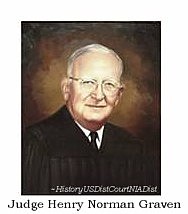 [Section 6, Page 8] Judge Henry N. Graven, who was on the district bench here at the time of the
Ontjes-McNider trial, was in 1944 appointed judge of the United States District Court, Northern Division. He now
[1953] lives in Greene.
[Section 6, Page 8] Judge Henry N. Graven, who was on the district bench here at the time of the
Ontjes-McNider trial, was in 1944 appointed judge of the United States District Court, Northern Division. He now
[1953] lives in Greene.
NOTE: Judge Henry Norman Graven, the son of Endre and Elsie (Thompson)
Graven, was born in St. James, Minnesota on
June 1, 1893, served as a U.S. Army combat engineer (1166 Demobilization Group) during World War I, 1919 to 1921. While stationed in France and waiting
to return to the States, he attended law school at the University of Dijon. Upon receiving his LL.B. from the University
of Minnesota Law School in 1921, he set up a private law practice in Greene, Iowa with his brother James. He married
Helen T. Davis in Minneapolis on March 21, 1926. He served as a special assistant
to the state attorney general of Iowa in 1936 and 1937; council to the Iowa Highway Commission;
12th Judicial District Court of Iowa from 1937 to 1944, appointed by Governor Kraschel; and, nominated by President
Franklin D. Roosevelt and
commencing March 24, 1944, as a federal judge on the United States District Court of Northern District of Iowa where he
presided as chief judge in 1961. Judge Graven held court as a federal judge in New York, North Dakota,
Florida, Texas, Louisiana, California and Puerto Rico. He also served in many advisory capacities to numerous
organizations and schools. Judge Graven died on February 1, 1970 at age 76 years in San
Antonio, Texas, while on assignment in the western district of Texas. He was interred at Rose Hill Cemetery, Greene, Iowa.
~ SOURCES: "Biographical Directory of Federal Judges at fjc.gov/servlet/nGetInfo?jid=901&cid=999&ctype=na&instate=na
"Henry Norman Graven." History of The United States District Court for the Northern District of Iowa, 1882 - 2000.
Pp. 20-26. 2003.Henry N. Graven obituary
* * * * * * * * * * * * * * * * * * * * * * * * *
1940: START PREPARATION HERE for POSSIBLE WAR EMERGENCY
[Section 6, Page 8] Mason City, with other parts of the nation, got its first impressions of the war
that loomed inevitably ahead, as National Guardsmen left for special maneuvers at Camp Riley, Minn., in August, 1940.
Hitler had entered Poland in September, 1939, and in the spring of 1940 invaded Norway, Denmark, France, Belgium and
Holland and was starting his air attack on Britain.
In October, 1940, a draft law was put into operation and many
Mason Cityans and other youths throughout the land knew they would soon be in training.
In the summer of 1940 the
national political conventions were held, with Mason City eagerly eyeing the Republican conclave, where Hanford
MacNider was pledged by the Iowa delegation for the presidential nomination.
That convention, however, was swept
off its feet by the meteoric rise of Wendell Wilkie and all other candidates were pushed aside.
This wasn't the first
time that the name of Hanford MacNider had been before a national GOP convention. At the 1928 convention when Herbert
Hoover was nominated for President, MacNider was runnerup to Charles Curtis as the nominee for vice president. By that
time he had served as assistant secretary of war under President Coolidge. President Hoover named him minister
to Canada.
A SOLDIER'S FAREWELL
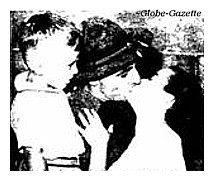
When Mason City's three national guard units left for maneuvers at Camp Riley, Minn., in August, 1940,
there were many scenes similar to this one, in which Cpl. F. W. Wilkins bade goodbye to his wife and their 3-year-old
son, Jim.
* * * * * * * * * * * * * * * * * * * * * * * * *
1941: NATIONAL GUARD INDUCTED;
"ONE FOOT in HEAVEN" in MOVIES
[Section 6, Page 9] In February, 1941, the thee National Guard Companies in Mason City - Headquarters,
F and H, a total of 200 men - were inducted into service and sent to Camp Clairborne, La., and the following summer
took part in large scale maneuvers as training for combat.
The same year, the movie of Hartzell Spence's book, "One
Foot in Heaven," was released. The book is the story of the life of Hartzell Spence's father, Dr. William
H. Spence,who served as pastor in Mason City from 1929 to 1935.
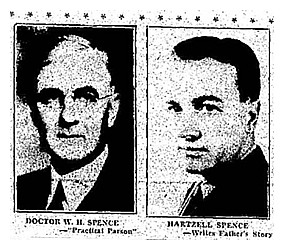
Immediate SuccessThe book tells how Doctor Spence was preparing to study medicine when he
felt the "call" and went into the ministry. He started his ministry at the turn of the century when Methodist discipline
forbade cards, theaters, cooking on Sunday, dancing and other pleasure and conveniences.
In `1941 the film was released starring Frederic March and Martha Scott. The world premiere was in Washington before an
audience of high officials. The movie proved a superb presentation of the book.
Wrote Number of
Books
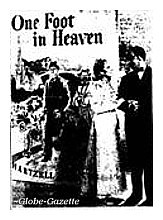 Spence started writing at an early age and by the time he wrote "One Foot" had a whole trunk full
of rejected manuscripts, mostly fiction. When he turned to the subject with which he was most familiar,
the life of his father, he was an immediate success. He sold Whittlesey House the book after the publishers had seen
only two chapters.
Spence started writing at an early age and by the time he wrote "One Foot" had a whole trunk full
of rejected manuscripts, mostly fiction. When he turned to the subject with which he was most familiar,
the life of his father, he was an immediate success. He sold Whittlesey House the book after the publishers had seen
only two chapters.
Since then Spence has written a number of books, notably, "Radio City," "Get Thee Behind Me," "Vain
Shadow," the story of the Spanish conquistadors in the Amazon Valley, "No Place Like Home" and "Happily Ever After."
He and his family live on a farm at Essex, Conn.
NOTE: John "Hartzell" Spence was born February 15,
1908, Clarion, Iowa. During World War II he was the founding editor of Yank, the Army Weekly magazine. After World
War II he retired to "Gaston Hall," his farm near Orange, Virginia, and died May 9, 2001 at the age of 93 years.
SOURCE: legacy.com/obituaries/hartfordcourant/obituary.aspx?pid=51410
* * * *
GUARDSMEN LEAVE FOR CLAIBORNE
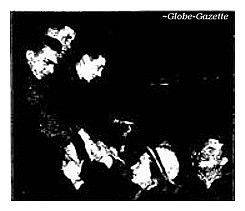
[Section 6, Page 9] When the three Mason City National Guard companies, Headquarters, F and H, left
Feb. 28, 1941, for a year's training at Camp Claiborne, La., everyone knew the war clouds were darkening over
America. Scene such as this were typical at the Great Western [railroad] station as the guardsmen bid farewell to
dear ones.
* * * * * * * * * * * * * * * * * * * * * * * * *
WILL LEAD PARADE to CAMP THURSDAY
Commanding officers of the three Mason City national guard units of the 133rd infantry, which are leaving
Thursday at 7 p. m. for a year's active duty at Camp Claiborne, La., are shown above.
At the left is Capt. Stuart
N. Grummon, commander of Company H, senior local officer and acting commander of the 2nd battalion in the absence of Lieut.
Col. Henry R. Heath, now stationed at Fort Benning, Ga. Captain Grummon has acted as garrison commander of all local
guardsmen in their two week mobilization period in Mason City.
In the center is Capt. F. B. Shaffer, commanding officer
of Company F, and named as transportation officer for the trip to Louisiana.
At the right is 1st Lieut. Will E. Hall,
commanding officer of the 2nd battalion headquarters detachment.
Local residents of 25 years ago pointed out that
Lieutenant Hall is the only member of the three companies now who took part in the march to the train in 1917 over the
same identical route as the one to be used Thursday evening from the armory. He quit high school at that time to join
Company A of the national guard. He, Captains Grummon, and Shaffer, and 1st Lieut. Charles E. Van Horn of Company F
are the only men in the local units who took part in the World war [I].
(Locke photos, Kayenay
engraving.)

The thousands of pyramidal tents and hundreds of permanent buildings shown in this aerial
photograph of Camp Clairborne, La., will furnish national guardsmen in the 133rd infantry from Mason City area with a
home for the coming year. Iowa, Minnesota, North Dakota and South Dakota national guard troops in the 34th division
are arriving daily at the $12,000,000 cantonment, which will include troops of all principal branches of the army's
various "arms" - artillery, infantry, engineers, medics, and so on.
Camp Clairborne is a complete tent city, providing
accommodations for 30,000 soldiers. It will belong exclusively to troops of the 34th division, and will be a self-sufficient
unit. The army division is the fighting unit of the army, the smallest organization which contains within itself all
branches of the army necessary to wage complete warfare, to defend and supply itself fully.
Mason City units of the
133rd infantry are scheduled to leave in a special troop train Thursday at 7 p. m., following a special parade and
farewell demonstration at the Mason City Great Western railway station.
GUARDSMEN in FAREWELL PARADE THURSDAY EVE
MESS FUND TO BE
HANDED OVER IN FINAL CEREMONY
Mayor and Others on Speaking Program for 15 Minutes at Station
Mason City national guardsmen will leave the local armory in parade formation at 6:15 p. m. Thursday in their last
march before entraining for a year's training at Camp Clairborne, La.
After marching down State street to Federal
avenue, up Federal avenue to Second street north, and from there west to the Great Western passenger depot at 600
Second street northwest, they will pause for a brief farewell ceremony, then immediately board the special troop
training leaving at 7 p. m. for Camp Clairborne, La.
Mayor Arleigh Marshall will head the group of speakers in the
15 minute farewell ceremony at the railroad station, which will open at 6:45 beside the troop train.
Capt. Stuart
N. Grummon, garrison commander, will respond on behalf of the local guardsmen.
Also on the farewell program
will be short messages from the American Legion, to be delivered by Commander W. D. Lattimer; from the Veterans
of Foreign Wars, to be delivered by Commander Siert Schoon; from the Reserve Officers Association, to be delivered
by John J. Adams, president.
Harry W. Odle, chairman of the mess fund committee, will make a formal presentation of
the funds collected for the local guardsmen.
The railway station area will be floodlighted and a public address
system provided for the occasion, and the ceremony will be broadcast over station KGLO, according to John van der
Linden, chairman of the Junior Chamber of Commerce committee in charge.
The speakers of the evening will precede
the parade in two special automobiles, and a colorguard furnished by the two veterans' organizations will head the
guardsmen in their march to the depot. Dr. John Hood of the Junior Chamber is in charge of arrangements for this
march.
Members of the three local guard units, Company F, Company H and headquarters detachment, 133rd infantry,
spent Wednesday loading equipment and supplies in two baggage cars that will accompany the troop train.
Loading was
scheduled to be completed Thursday morning and guardsmen were to be given Thursday afternoon off, according to
Captain Grummon, to wind up personal business and say farewells before leaving.
To prevent confusion at the entraining,
the area immediately around the troop Pullmans will be roped off by a cordon of Junior Chamber members in charge of
Stratton Shannon, and civilians should take care of all farewells in the afternoon so that this area may remain
cleared, the captain stated.
An order just received from regimental headquarters at Waterloo states that no intoxicating beverages will be allowed
to be taken or consumed on the train, Captain Grummon said. To maintain the dignity of the army, train discipline
will strictly forbid yelling and boisterous or profane language or actions at station stops enroute.
Captain Grummon
announced that First Lieut. Joseph W. Morris, formerly commissioned in a reserve status with the "National Guard
of the United States," had been regularly assigned to Company H, effective this week. Lieutenant Morris has served
in Company H as a sergeant since 1927.
MASON CITY BOYS in KHAKI ARRIVE in CAMP for YEAR'S TRAINING
These photos from Camp Clairborne, La., show the sort of homes Mason City guardsmen will occupy during the
year ahead.
At the left is one of the small frame houses such as have been built for regimental commanders. In the case
of local guardsmen, this commander is Col. Howard J. Rouse of Waterloo, commanding officer of the 133rd infantry. In the
background can be seen some of the small wall tents which will house other officers, two to a tent.
At the center is
a company street, bordered on each side by rows of pyramidal tents. At the far end of each is the frame latrine and
shower house, at the near end the frame mess hall.
At right is a closer view of the tents themselves. In the foreground
are the tent frames, in the rear frames covered with their canvas roofs. All tents, latrines and mess halls will be
provided with electric lighting, gas heat, board floors, etc. The company street shown at the right, as yet ungraded,
will be smoothed, rolled, and spread with gravel.
While the main part of the camp is completed, a few finishing
touches remain. In the camp are 22 miles of concrete highway, 15 miles of secondary roads with blacktop paving and 12
miles of gravel roads and streets. Each tent is 16 feet square, is provided with side walls six feet, eight inches
high, and is screened.
(Photos courtesy of Davenport Democrat.)
Mason City national guard units arrived at Camp Clairborne Saturday morning at 7 a. m. and immediately began moving
into their tent homes for the coming year. After the men are well settled, they will begin training "on the range,"
a special course in target work in the field. Other preliminary training will include special practice in
marching and in physical conditioning.
Actual maneuvers in the field, with the various companies acting as part of
the larger units in complicated war games, will not be undertaken until later.
ADDITIONAL SOURCES: ~The Globe-Gazette. Wednesday, February 26, 1941. Pp. 1, 9 & 21.
The Globe-Gazette. Saturday, March 01, 1941, p. 7.
* * * * * * * * * * * * * * * * * * * * * * * * *
Mason City Fire Department
* * * * * * * * * * * * * * * * * * * * * * * * *
1942: PLYMOUTH BOY in TOKYO RAID
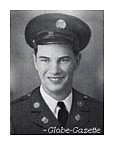 [Section 6, Page 9] When the first news came in early 1942 that Americans had struck a daring air blow
at Tokyo, Americans refused to believe it. First news of the bombing of the capital came in a Japanese announcement
April 18, 1942. There was no confirmation.
[Section 6, Page 9] When the first news came in early 1942 that Americans had struck a daring air blow
at Tokyo, Americans refused to believe it. First news of the bombing of the capital came in a Japanese announcement
April 18, 1942. There was no confirmation.
Several days later President Roosevelt confirmed that Lt. Gen. James
Doolittle and his men actually had bombed Tokyo, blandly asserting that the 16 B-25's had taken off from
"Shangri-la."
On May 20, as the identity of the 79 men who took part in the raid became known, it was learned that
Cpl. Leland Faktor of Plymouth had been a member of one of the crews. With the news came the announcement that the
youth, who had enlisted in the Army the previous Aug. 8, had been awarded the distinguished service cross.
Six days
later the Plymouth youth, the son of Mr. and Mrs. Louis Faktor, who live on a farm, was reported killed in action and
buried with military honors "somewhere in China."
It was not revealed until long afterwards that the land planes
taking part in the raid had made spectacular takeoffs from the carrier Hornet. Of Doolittle's 79 flyers three
were executed, one died in prison, five were killed in emergency landings [Cpl. Faktor was one who died upon his
landing after parachuting out of his B-25.]
The raid did little real damage to Japan's war potential, but it made
psychological fireworks in both Japan and the United States. Up to that point the United States, which had been
attacked at Pearl Harbor the previous Dec. 7, had been rocking under a series of terrible blows. The naval victory at
Midway was two month in the future and the successful invasion of North Africa seven months away.
NOTE: Cpl. Leland Dale Faktor was born in Plymouth on May 17, 1921. After completing Airplane Mechanic's School at Chanute Field,
Illinois, he was assigned to the 95th Bomb Squadron, 17th Bomb Group, U.S. Army Air Force at McChord Field, Washington.
Cpl. Faktor was the engineer/gunner aboard the B-25 Whiskey Pete, the third to take off from the Hornet
and under the command of Lt. Robert M. Gray. After completing a successful mission, the B-25s headed for the coast of China,
however with night approaching and low fuel, Whiskey Pete's crew were forced to bail out over Chuchow, China. Cpl.
Faktor was killed when he landed and fell down a cliff. He was interred with military honors at Wan Tsuen, China. In 1949,
Cpl. Faktor's body was returned to the United States and he was reinterred at the Bohemian Cemetery, Plymouth, Iowa.
* * * * * * * * * * * * * * * * * * * * * * * * *
1943: WIN BASKETBALL TOURNEY
[Section 6, Page 9] While the tide of the World War was gradually turning toward the Allies, with the
successful invasion of Africa and the defeat of the Germans at Leningrad, Mason City helped turn away the tragedies of
war with another state high school basketball championship.
Mason City's championship basketball team was one of the
three in comparatively recent history. No team came close to this inspired group of players which went 30 games without a
setback to the state title with a 39 to 21 win over Webster City in the championship game. The members of this great
club shown above were: Forwards Paul Bruns and Peewee Day; Center John Holmen; and Guards Fats Day and Lloyd Klein.
This 1943 team averaged 46 points per game through its 30 games while holding opponents to only 23.3 points per game. It
marked the final season of coaching at Mason City for Judge Grimsley, who had all three state championship Mason City
teams. His football team the previous fall also was unbeaten with the Day twins and Bruns key cogs in the gridiron machine.
The 1940 "dream team" also was an undefeated club. This team went 32 games through a long season without a loss and took
the state crown at Iowa City by beating Ames 41-30 in the finals. This club composed of Max Major and Bill Barbour as forwards,
Don Pickell at center and Bill Colloton and Jim Humphrey as guards, was a team of defensive perfection. The offensive
average for the season was only a modest 32.2 points per game but the defensive mark was a sensational 18.1.
The 1940 and 1943 Mason City club were two of the three teams ever to go undefeated for the season in Iowa high school
competition. The other school to post such a record was little Class B Melrose which won the title in 1937.
The first Mason City team to take the state crown was the 1935 club, which, after an average season, caught fire during
tournament play and took the title at Cedar Falls by beating Grinnell 28-17 in the finals. Three of the stars of this
team were Howard Stoeker, Gale Lane and Henry Hart.
NOTE: Paul Bruns was born January 10, 1925, and died
August 1, 1952, interment made at Bethel Reformed Church Cemetery, Aplington, Iowa.
Loran A. "Pee Wee" Day, Jr. was born in Davenport, Iowa on February 4, 1925, the twin of Lawrence "Fats" Day.
They were the sons of Loran Allen and Selma (Jaeger) Day. During the twins'
senior year, the family moved to Mason City. After high school, Pee Wee enlisted in the U.S. Marine Corps and served in the
Pacific Theater of Operations during World War II. He received shrapnel wounds at Iwo Jima. Upon his return to the States
in 1945, Pee Wee and his brother Fats won scholarships at Northwestern University where they participated in collegiate
baseball and football. They were the first twins to ever start in a Rose Bowl game, in 1949 when Northwestern defeated
California 20-14. Although he was offered contracts by the St. Louis Cardinals and the Chicago Cardinals, Pee Wee sought
employment with Martin-Marietta Cement Company as a sale representative, retiring in 1990 as manger of contract sales.
He was inducted into the Iowa High School Hall of Fame for his achievements in baseball, basketball and football. He died
at the age of 73 years on May 9, 2003, Davenport with interment made at Davenport Memorial Park.
Lawrence A. Day served during World War II with the Seabees. He was employed
as an accountant with Standard Oil in Chicago, then with Pepsi-Cola with which position transferred to their New York
headquarters. He held various sales, marketing and manager positions with Pepsi-Cola prior to his retirement in 1990.
He died April 4, 2012 at the age of 87 years, interment was made at Christ Church Cemetery, Manhasset, New York.
John "Al" Holmen was born near LeRoy, Minnesota, the son of John and Alma (Hege) Holmen. He was employed as a truck
driver for a construction company out of Hopkins, Minnesota. He died at the age of 79 years on November 9, 2004, with
interment made at Wayne Cemetery, McIntire, Iowa.
J. A. "Judge" Grimsley was inducted into the Iowa High School
Coaches Hall of Fame.
Maxfield Melvin "Max" Major was born January 14, 1922 in Mason City, and died April 20, 1969 at Sloan, Iowa, interment
was made at Elmwood-St. Joseph Cemetery.
Dr. William "Bill" Barbour was born in 1923, and died in 1956, interment was made at Elmwood-St. Joseph Cemetery.
Don Pickell was inducted into the Iowa High School Boys Basketball Hall of Fame.
James T. "Jim" Humphrey
was born in Hesper, Iowa on March 16, 1922, the son of John and Beata Humphrey. He served during World War II with the
U.S. Navy and after the war eventually earned his M.A. degree in economics in 1949. He taught history at Ottumwa, Centerville
and Aldon High Schools prior to his retirement in 1991. Jim was inducted into the Iowa High School Boys Basketball Hall of
Fame. Jim died on January 11, 2010, Iowa City. His body was donated to the University of Iowa College of Medicine.
Gale Wilbert Lane was born December 6, 1917, and died October 10, 2000 at Pharr, Texas. A longtime employee
of Armour and Company, he was a supervisor. Interment was made at Memorial Park Cemetery.
* * * * * * * * * * * * * * * * * * * * * * * * *
HE WAS FIRST IN DRAFT
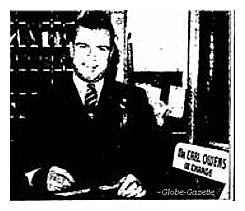
[Section 6, Page 10] Carl Owens is shown at his job as clerk at the Eadmer Hotel back in 1940 when he
became distinguished as the holder of the first draft number drawn from the "bowl" in Washington, D.C., on Oct. 16, 1940.
His number was 156. He made a fine record in the war, serving in Hawaii, New Guinea and the Philippine Islands. He
took park in the Lingayen gulf landing and was wounded on Luzon in March, 1945.
* * * * * * * * * * * * * * * * * * * * * * * * *
TRAINING IN IRELAND
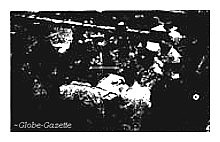 [Section 6, Page 10] This shows the 133rd Infantry in training in Ireland. Capt. Jacob Magnani is next
to the charting board facing the camera. To the right is Lt. Earl R. Newman, who won the congressional medal of
honor for his services in the Lanuvio line breakthrough in Italy two years later.
[Section 6, Page 10] This shows the 133rd Infantry in training in Ireland. Capt. Jacob Magnani is next
to the charting board facing the camera. To the right is Lt. Earl R. Newman, who won the congressional medal of
honor for his services in the Lanuvio line breakthrough in Italy two years later.
NOTE: Capt. Jacob
Magnani, born in 1912, attained the rank of Major. He died in 1981 with interment made at Elmwood-St. Jospeh Cemetery.
* * * * * * * * * * * * * * * * * * * * * * * * *
1944: "PALACE GUARDS" HEROIC FIGHTERS in ITALY
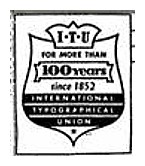 [Section 6, Page 10] While Cerro Gordo boys fought in battles all over the world in War II, the largest
concentration of them in one place were the members of the three National Guard Companies, F, H and Headquarters in the
2nd Battalion of the 133rd Infantry.
[Section 6, Page 10] While Cerro Gordo boys fought in battles all over the world in War II, the largest
concentration of them in one place were the members of the three National Guard Companies, F, H and Headquarters in the
2nd Battalion of the 133rd Infantry.
Two hundred and sixty members of these companies - 140 of them from Cerro Gordo
County - left Mason City Feb. 28, 1941, for Camp Claiborne, La., for training before they went overseas. By the time
the battalion had been given further training in Ireland and later served as "palace guards" for Gen. Eisenhower's
headquarters in Africa and finally rejoined their comrades in the battle for Italy in 1944, there were only 47 Mason Cityans
left. A few were casualties, but others had been transferred to other units.
When the 2nd Battalion rejoined the regiment
on the Anzio beachhead in the spring of 1944 it had the magnifying glass of the other units upon it for it was yet to
experience the rigor of bloody battle. How gallantly the 2nd Battalion fought in the remainder of the war is now a part
of history.
Made Diary of WarThe only Mason City officer left with this battalion at this
juncture was Maj. Jacob Magnani, battalion executive officer. Capt. Philip Thurtle had become regimental gas officer.
Magnani's diary of the experiences through the war proved a valuable record when the struggle was over and it is from that
document that most of the facts of this story are drawn.
Capt. Fred Shaffer, commander of F Company, when the guard left,
was transferred to the aircorps and became a training officer. Capt. Stuart N. Grummon of F Company became chemical officer
of the 69th Division and Lt. W. E. Hall, commanding officer of Headquarters Company, became ill and went to the hospital.
When the guard left Magnani was 2nd lieutenant in H Company and later became commanding officer of Headquarters Company
and then executive officer of the battalion.
After a year's training in Louisiana the 133rd sailed with the remainder
of the 34th Division for Ireland.
On ManeuversHere the division took part in maneuvers,
with other American, as well as a British division. In August part of the battalion was transferred to the 168th, which was
to train in beach landing in Scotland.
On Sept. 5, 1942, the 2nd Battalion was filled to full strength, given the latest
and best equipment in the division and assigned to the Security command of the Allied Force Headquarters, directly under
Gen. Eisenhower. On Dec. 26 the battalion boarded ship and on the following Jan. 3 was in Algiers, part of the big landing
in North Africa.
On Oct. 21, 1943, Capt. Virgil Brown was transferred on the army rotation plan, leaving Maj. Magnani
as the last of the original officers. Meanwhile the invasion of Italy was underway, having started with the attack on
"Fortress Europe" in September, 1943.
By the following spring the 2nd Battalion was on its way to join the regiment,
landing ad Anzio and taking part in its first big battle on May 25, 1944, capturing Cisterna.
In the attack on
Lanuvio on the northward push toward Rome, F Company was the first unit of the
division to get into the city. While capturing Genzano, the Americans learned the Germans were pulling out of Rome.
Maj.
Magnani had set up his headquarters in a beautiful home with the expectation that the division would spend a few days
resting. But the next morning, June 5, the regiment was ordered to move, walking 17 miles, reaching an assembly area
about 4 p. m.
Walk to Rome"Late that afternoon," he added, "we were ordered to walk to Rome
about 20 miles straight away, but walked over 30 miles because the roads were mined and bridges blown up."
The next day
the battalion started the chase after the Germans, with the 2nd Battalion units leading the division, in fact the whole
5th Army. After a brief training period, in preparation for mountain fighting the campaign was resumed with Italian
partisans providing assistance.
When the battalion reached Mount Coronato, Germans cut the lines to the rear and the
troops relied on food from the partisans hiding in the mountains. They were guided to the town of Castagneto-Carducci, which
the battalion captured at 9 that night, catching the Nazis by surprise. Throughout the night German trucks were captured
as they came into the town.
Next was the battle of Cecina, described as one of the toughest battles that the battalion
was in. "We lost a lot of officers and men. A company was almost wiped out."
The advance continued through the mountains,
each one looking bigger than the last and all supplies came up by mules. By July 22 the battalion reached the Arno River,
together with the other units of the division. Bridges were out and it was difficult to get supplies even by mules.
On Sept. 22 the battalion captured 30 prisoners and Maj. Magnani records that "it looks like the Germans are cracking
up on our front." But further heavy fighting with many casualties followed. Some of the battalion were captured. Finally
tank reinforcements, making it possible to capture the objective. Continual rains were coming and there was difficulty
in getting rations to the men.
Attack ResumedAs the attack was resumed on Oct. 4, the Mason
Cityan stated "we had 12 tanks with us and we were trying something new. F Company was to ride the tanks into the next
town. The Germans were holding the mountain between us and the town. Of the 12 tanks that started none made it, but our men
did. It was a surprise and it really surprised the enemy."
The next big objective was Mount Belmonte. It was raining
again and it was difficult getting the tanks through, but on Oct. 23, the notion was made that "We finally reached the top
of Mt. Belmonte."
The 5th Army stayed on the defense the remainder of the winter. The 2nd
Battalion was kept busy with probing attacks and scouting missions. The biggest of these was one F Company
made north of Livergnano. On April 16, 1945, the 5th Army stated the final assault on the Genghis Khan line which the Germans
had been holding all winter protecting Bologna and the Po Valley. The 133rd Infantry was the first to enter Bologna.
On April 23 the 34th Division started its last drive of the war. On the first day the 2nd Battalion walked 27 miles, at
times being in front of the Germans. The "History of the 34th Division" states that "on the 25th of April the 2nd
Battalion drove through Fidenza, cleared out snipers and proceeded on to the Cortemaggiore northwest of Fidenza, with the
mission of attacking Monticelli, an enemy strong point on the south bank of the Po.
"Here now occurred one of those
weird instances where the attacker is being pursued by the attacked. Early on April 27, the rear command post at
Cortemaggiore made contact with a column of German infantry with estimated strength of 1,500. In the light of the
approaching dawn, the column marched past our rear command post in the direction of San Pietro. Capt. Edward Meany Jr.,
immediately phoned Lt. Col. Horran warning of the oncoming enemy force.
Situations Tense
"In the meantime forward at San Pietro Lt. Col. Horran prepared to meet the oncoming German column. It was a tense situation,
600 isolated American infantrymen pocketed in the village with enemy artillery from the northwest already raining in shells
on the dauntless men and 1,500 German infantry men pouring in from the south. This again was a time to test men's souls.
"Commander Horran's situation was growing desperate. He radioed for reinforcements and called for artillery support.
Reinforcements arrived in the form of 150 clerks, drivers and kitchen personnel, while division artillery support
zeroed in on the enemy's heavy gun positions, silencing the battery that had been threatening from the northwest.
Men of the 2nd Battalion now went to work on the enemy inflicting heavy casualties, capturing 450 prisoners and
neutralizing the equivalent of a German re-enforced regiment. It was a job well done."
On May 2 the Germans in Italy
surrendered ending the war in that theater.
NOTE: The regiment returned with the 34th Division to
the United States in October of 1945.
* * * * * * * * * * * * * * * * * * * * * * * * *
PHYSICIANS SERVED on ALL WAR FRONTS
[Section 6, Page 10] Mason City physicians had important roles in World War II, serving on all fronts.
Col. G. E. Harrison of the Park Hospital was in command of a station hospital in Corsica and later transferred to eastern
France. Maj. Harry Marinos spent 31 months in the Pacific. Capt. Draper Long was in Egypt as a flight surgeon. Dr.
John M. Hood was chief of the dental staff of a evacuation hospital i Texas before going overseas.
To
Canal ZoneCapt. Jay Houlahan went to the Canal Zone, then to the Galapagos Islands with a heavy bombardment
unit. Lt. Cmdr. Don FitzGerald went out with the Pacific fleet to become base dental officer at New Guinea. Capt. W. C.
Egloff went to England as chief of medicine with the 197th general hospital.
In Rescue Flight
Col. Walter A. Carlson was in a dramatic rescue flight, that of flying to the aid of a Panama farmer in an Army plane
and landing on an emergency field after stripping the plane to bare necessities. The man rescued had to be carried
five miles through jungle country to the airfield.
One of the first physicians to leave on war duty was Capt. Irving
Sternhill, who was stationed with troops in Iceland. Lt. Col. C. O. Adams ended up the war with a hospital in
Vancouver, B. C., and Capt. R. R. Flickinger was stationed in several hospitals in the U. S.
NOTE:
Harry G. Marinos, M.D. was born in 1913, and died in 1991, interment was made at Elmwood-St. Joseph Cemetery.
Dr.
Draper L. Long was born March 12, 1906, the son of William E. and Sue E. (Lyon) Long, and died August 30, 1981,
interment was made at Memorial Park Cemetery.
Dr. John M. Hood was born May 22, 1913, and died October 6, 1983, interment
was made at Memorial Park Cemetery.
Dr. William Chauncey Egloff was born March 16, 1901, and died May 19, 1958,
interment was made at Elmwood-St. Joseph Cemetery.
Dr. Roger R. Flickinger died June 10, 1959, interment was made
at Memorial Park Cemetery.
* * * * * * * * * * * * * * * * * * * * * * * * *
DECKER GENERAL MANAGER
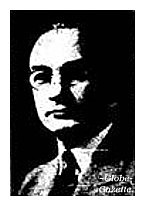
[Section 6, Page 11] Fred G. Duffield was named general manager of Jacob E. Decker and Sons in 1936, after
he had been employed by the company 29 years. He served in that capacity until his death in 1943.
NOTE:
Fred G. Duffield was born May 28, 1883, Shenandoah, came to Mason City in 1886 with his family,
and died at the age of 60 years August 16, 1943, interment was made at Elmwood-St. Joseph Cemetery. He was,
among numerous other positions within the community, the
general chairman of Mason City's 75th anniversary in 1928 and one of the first presidents of Mason City's Lions Club.
* * * * * * * * * * * * * * * * * * * * * * * * *
1945: WORLD WAR II ENDS;
ATOM BOMB OPENS NEW ERA
[Section 6, Page 11] Many events transpired to make 1945 a year of world shaking events. It brought the
surrender of the German armies May 7 and on the following Aug. 14 Japan surrendered.
Transcending all other
events from the standpoint of future possibilities was the dropping of atomic bombs on two Japanese cities, Hiroshima on
Aug. 6 and Nagasaki on Aug. 9, revealing that the United States and her allies had won the victory in the greatest
scientific race in history.
Only a handful of people knew on July 16,1945, about the tremendous experiment in New
Mexico that showed the atomic bomb was a success. News of this came after President Truman announced that the
Japanese cities had been bombed.
Awaited Proclamation
When the Germans surrendered on May 7 the Globe-Gazette ran the huge headlines, "EUROPEAN WAR ENDS." Mason
City awaited the proclamation of President Truman naming May 8 as V-E Day before planning to celebrate the victory.
The observance of V-D day in the community was quite, in marked contrast to the noisy celebration of Nov. 11, 1918, which
marked the close of War I. Speakers appeared at the theaters in the afternoon. At 5 p. m. Justice W. L.
Bliss of the Iowa Supreme Court had charge of the retreat in Central Park.
Held Mass Meeting
In the evening a large mass meeting was held at the Roosevelt Fieldhouse, at which the speakers were the Rev. Marvin Kober
of the First Methodist Church and Atty. R. F. Clough.
When the news of Japan's surrender reached Mason City at 6 p.m. Aug.
14, the Globe-Gazette placed a huge banner line, "WAR ENDS" at the top of page one and the city began celebrating.
Church bells rang and thousands of citizens converged on the downtown area, where whistles were blown and paper scattered
to give vent to the joy of the occasion.
* * * * * * * * * * * * * * * * * * * * * * * * *
1946: INTERNATIONAL MINERALS STARTS CITY'S
POST-WAR INDUSTRIAL GROWTH
[Section 6, Page 11] With the war over, Mason City turned its attention to the activities
of peace, among them efforts to expand the industrial development of the city.
The year 1946 was a significant one for it marked the passing of 100 years since Iowa
became a state. Mason City joined in celebrating the event with a glorified band festival in June.
NOTE: The Globe-Gazette, in the June 10th, 1946 issue, stated that Cerro Gordo County's returned veterans of World War Ii
would be honored guests at Mason City's centennial observance which would be held on Tuesday, June 18. "Features of the
day will be a fun-fest at Roosevelt fieldhouse scheduled for 7:30 p. m., including a "Dutch" Schmitt vaudeville troup
from
Des Moines, to be followed by a pavement dance at Central park at 10 p. m. With most of the county's estimated 6,000 GI's
back in civilian clothes, the crowd at the fieldhouse is expected to tax its capacity, so attendance has been
limited by the committee to "the boys with the golden eagle' and a guest apiece. The discharge button is the admission
ticket for 2." The community observed a moment of silence in memory of the 191 Cerro Gordo County soldiers who did not
return home. The following day, Wednesday, June 19, was designated as Aviation Day with the dedication of Mason
City's municipal airport at 10 a.m., christening of Mid-Continent airliner "Miss Mason City" and the U.S.A.A.F. air show
and dog fight. Thursday, June 20 was the North Iowa Band Festival during which the U. S. Army band gave marching demonstrations.
Not only was this event a celebration of Iowa's Centennial, it was the return of the North Iowa Band Festival after a four-year
hiatus which occurred during the war years.
The Globe-Gazette's headline on page one of the June 20, 1946 issue stated, "Largest Crowd in History ~ 20,000 See Bands March."
Click on image below to view enlargement of the photographs;
click on your browser's 'back' button to
return to this webpage.
* * * * * * * * * * * * * * * * * * * * * * * * *
INTERNATIONAL MINERALS ACID PLANT
The Chamber of Commerce played a key role in obtaining the re-zoning of a tract of land on 12 N.W. and in 1946 the first unit
of the International Minerals and Chemical Corp. was built and put into operation.
The first unit of the International
Minerals factory consisted of a small plant for dry mixing of fertilizer in a building 100 feet wide and 200 feet long. Almost
before it was in operation, however, International's officers recognized that fertilizer use in Iowa was growing so fast
that expansion was needed immediately.
Size of Plant TriplesThe size of the plant was then
tripled and facilities installed for treating phosphate rock with sulphuric acid to produce superphosphate. The phosphate rock
come from the company's own mines in Florida and the acid was purchased from manufacturers.
In 1949 and 1950 more
area was added to the plant, including a building that increased storage capacity by 20 per cent. Later another storage plant
was erected.
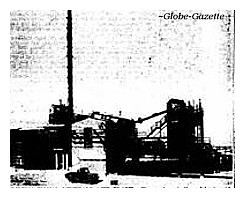 Shown at left is the sulphuric acid plant of the International Minerals and Chemical Corp., part of the company's
million dollar chemical fertilizer plant in Mason City.
Shown at left is the sulphuric acid plant of the International Minerals and Chemical Corp., part of the company's
million dollar chemical fertilizer plant in Mason City.
In 1950, the company started construction of its
own sulphuric acid plant in order to be certain of the supply for the Mason City plant. This plant was completed in time for
a visit to Mason City by officials of the company in September, 1951 This group was headed by Louis Ware, Chicago, president
of the company.
Industry ExpandingInternational Minerals and Chemicals became part of
Mason City's industrial picture that is rooted to the Iowa soil. The importance of plant food in America's agricultural
economy has gained tremendous recognition in the last decade. Agronomists estimate crops produced in this country would be
considerably less in both quality and quantity if commercial plant foods were not used.
The company also is a large
producer of potassium and phosphate chemicals and its Amono products division is the world's largest producer of the
seasoning agent, monosodium glutamate which is marketed by International Minerals under the trade name of Ac'Cent to food
processors, restaurants, institutions and consumers.
* * * * * * * * * * * * * * * * * * * * * * * * *
1947: MODE O'DAY PLANT STARTS HERE
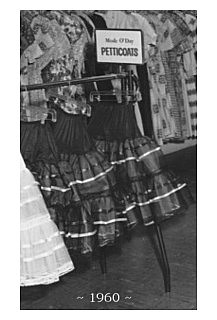 [Section 6, Page 11] Another manufacturing plant, the $100,000 Mode O'Day factory at 840 12th N.W. went
into operation in February, 1947. The hiring of approximately 125 workers, mostly women, was part of the preliminaries for
the opening by Don Roschi, plant manager.
[Section 6, Page 11] Another manufacturing plant, the $100,000 Mode O'Day factory at 840 12th N.W. went
into operation in February, 1947. The hiring of approximately 125 workers, mostly women, was part of the preliminaries for
the opening by Don Roschi, plant manager.
The Mason City plant, seventh in the Mode O'Day group, was set up for the
exclusive manufacture of ladies lingerie for distribution in Iowa and other midwestern and western states.
The Mode O'Day
Company was started in Los Angeles in 1932 and deals exclusively in moderately priced women's clothing, with more than
300 retail outlets.
Mode O'Day provided the type of employment long needed in the city, a place for women skilled in
operating sewing machines. It was the second large manufacturing plant to come after World War II.
NOTE: The Gamble-Skogmo conglomerate owned Mode O'Day stores and plants. At one time there were over 700 retail stores
across the United States which flourished until Gamble-Skogmo was sold in 1980 to the Wickes Corporation, which went
bankrupt in 1982.
* * * * * * * * * * * * * * * * * * * * * * * * *
WALTRIP BUILDS RADIO CHAPEL HERE
[Section 6, Page 12] One of the more dramatic church activities of this period was the construction of
Radio Chapel by Burroughs A. Waltrip in 1937 and 1938, consecting the activities in the building with a daily broadcast
over KGLO.
He was joined by Kathryn Kuhlman, 25, in February, 1938, to assist in raising $10,000 for completion of
the building, coming from Denver where she operated a tabernacle. On Oct. 18, 1938, Miss Kuhlman and Waltrip were
married.
Financial difficulties reached a climax in judgment given for $2,044.54 on Nov. 28, 1939, in an action
brought against Waltrip by George Kaduce, guardian for Andrew Kaduce, who alleged that Andrew "became unbalance mentally
by reason of unsound religious fervor" and that "Waltrip did exercise an undue influence" in order to get money for the
project.
The following May 16 Waltrip filed a petition for receivership and the building was closed until December when
the court approved the purchase of the building by the Rev. Carl J. Sentman, pastor of the Baptist Church at Sheffield, with
most of the payment extending over a 10 year period. Since then Pastor Sentman has directed an expanding program that has
included daily Bible broadcasts and the sponsoring of missionaries to foreign lands.
NOTE: Kathryn Johanna Kuhlman was born May 9, 1907 near Concordia, Missouri, the daughter of Joe and Emma (Walkenhorst) Kuhlman. In 1935, Kathryn
and Helen Gulliford established the Denver Revival Tabernacle in Denver, Colorado. Burroughs A. Waltrip came to preach at the
tabernacle early in 1937, staying to assume the pulpit for two months. He was invited to return in the autumn, which he did
with his wife Jessie and two children. Something happened for Jessie returned to their home in Austin, Texas with the
children. Waltrip asserted that his wife had deserted him. Upon completion of his obligations with the Denver Tabernacle,
Waltrip arrived in Mason City (1937) where he had been engaged to preach. After marrying Waltrip, a divorced man, Kathryn was
advised that she was not welcomed to return to Denver. Meanwhile, Waltrip's followers began to discover that it was he who
had deserted his first wife. Waltrip was a ruined man and all of his ministry invitations were withdrawn. Consequently,
Kathryn was losing engagements too since she was married to a divorced man. Upon repenting [divorce], Kathryn resumed
her ministry which gained momentum after a series of miracle healings occurred during her sermons, which many, expanding
into television programs, until her death on February 20, 1976. She was interred at Forest Lawn Memorial Park, Glendale,
California. Burroughs eventually left the ministry, wrote a couple of books, then sold concrete casket liners. The last
known address for him was Kansas City, Missouri. He was born September 18, 1903 in Pyburn, Texas. Waltrip's Radio Chapel
became the home for KGLO AM and FM radio and KGLO-TV.
* * * * * * * * * * * * * * * * * * * * * * * * *
1948: START BUILDING in WILLOWBROOK
[Section 6, Page 12] It was while gazing at the Harland Bartholomew and Associates maps of the proposed
street system and suggested parks and parkways for Mason City that Frank Pearce got an idea that blossomed into one of
the finest residential developments in the city's history.
The Bartholomew firm had been hired by the city in 1937 to
prepare a comprehensive plan for Mason City. Its maps showed highway 18's approach to Mason City from the west, dividing
into two graceful curves one bending north five blocks to First N.E. and the other south to Sixth for two proposed east
and west through streets. In this curvicular (sic) Y the engineers had proposed a parkway.
Out of this came the idea for
the development of Willowbrook, with the picturesque lagoon. Mason City as a result moved westward farther than
Bartholomew ever dreamed. He and his engineers had projected future growth to the southeast.
In 1947 Pearce and his
son, Kenet Pearce, filed a plan and proposal for an 80 acre sub-division west of Pierce Avenue and north of 4th S.W. laid
out with winding drives following the gently rolling contour of the land. The lots all had an extremely wide frontage
and care was taken to afford each lot a facing that gave its owners the benefits of broad vistas across the central
park area.
A grading contract was let immediately after the approval of the sub-division and by 1948 the construction
of beautiful homes in the addition got under way, continuing to the present time.
In the fall of 1949 the construction
of 76 apartment units in the Willowbrook addition got under way helping to relieve the housing shortage in Mason City.
The buildings were erected by John G. Miller Construction Company of Waterloo with Federal Housing Administration
approval. The first units were ready for occupancy the following spring.
HIS DREAM CAME TRUE
NOTE: Kenet Pearce, born June 1, 1920 in Mason City, served as the secretary for Willowbrook
Development Co., and was the owner of Pearce Realty Company.
* * * * * * * * * * * * * * * * * * * * * * * * *
ROCK ISLAND CELEBRATED CENTENNIAL
[Section 6, Page 12] In October, 1952, the Rock Island Railroard observed the 100th anniversary of its
initial 40-mile run from Chicago to Joliet, Ill.
Mason City with other points along the sprawling system joined in the
observance. The interest of this community in the road reaches back to pioneer day when one of the small lines later
absorbed in the big system was being built in this direction from Cedar Rapids.
That was in 1872. At that time Mason
City had already had the Milwaukee and the Central of Iowa (M. and St. L.). The Burlington, Cedar Rapids and Northern
was headed in this direction and Mason City residents thought it was coming to Mason City. Instead it went to Manly, where
it became a junction with another Rock Island line built in 1909 from Kansas City to Minneapolis.
The Rock Island
acquired the Burlington, Cedar Rapids and Northern in 1885 as part of its drive toward expansion in the west. It also
opened the way to the Twin Cities and took the railroad into South Dakota at Watertown and Sioux Falls.
The B.C.R. & N.
was made up of a hodgepodge of companies, some of which never operated as railroads at all. This was typical of the
early development of railroad.
One of the most ambitious of these companies was the Davenport, Iowa & Dakota Rail Road
Company, which had visions of reaching from Davenport to the Atlantic and out to the Pacific Coast and the British
possessions. Some 30 miles of track between Davenport and Bennett, Iowa, was all of the construction completed.
NOTE: The first railroad to cross the Mississippi River into
Iowa was the Mississippi and Missouri Railroad in 1956. This railroad later became the Chicago, Rock Island and
Pacific Railroad, which filed for bankruptcy in 1975. In June of 1980, the railroad was ordered to liquidate. Most of the
Rock Island Railroad in Iowa was acquired by the former Chicago and Northwestern Railway Company. SOURCE:
iowadot.gov/iowarail/history/history.htm
* * * * * * * * * * * * * * * * * * * * * * * * *
MASON CITY MAYOR
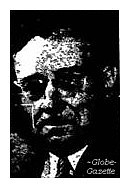
[Section 6, Page 12] Mayor of Mason City since 1945 is Howard E. Bruce, former
manager of the local division of the Standard Oil Company. Bruce was elected to head the city government after the
manager-council form was voted out, but has continued to maintain the manager system the most efficient.
NOTE: Howard E. Bruce was born in 1880, and died in 1978, interment was made at Elmwood-St. Joseph Cemetery.
* * * * * * * * * * * * * * * * * * * * * * * * *
LEE LOOMIS BECAME HEAD of LEE NEWSPAPER in 1949
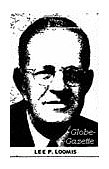 [Section 6, Page 12] Lee P. Loomis, publisher of the Mason City Globe-Gazette, became the chief
executive of 8 of the 10 newspapers which comprise the Lee Newspaper Group of midwestern daily newspapers in 1949 following
the death of E. P. Adler of Davenport.
[Section 6, Page 12] Lee P. Loomis, publisher of the Mason City Globe-Gazette, became the chief
executive of 8 of the 10 newspapers which comprise the Lee Newspaper Group of midwestern daily newspapers in 1949 following
the death of E. P. Adler of Davenport.
At the present time he holds the following officers in the corporations below:
He is president and board member of the Journal Printing Co., Muscatine; La Crosse Tribune co., La Crosse, Wis.; Star
Publishing Company, Lincoln, Neb.; Courier Printing Co., Ottumwa; Davenport Newspapers, Inc., including the Democrat and Times;
the Wisconsin State Journal Co., Madison, Wisc.; the Globe-Gazette Publishing Co., Mason City.
He is also
president and director of Lee Enterprises, Incorporated, Dover, Del.
He is vice president and director of the Star-Courier
Co., Kewanee, Ill., and chairman of the board of Mail O Graph, Inc., Kewanee, Ill.
Loomis started his newspaper
career on the Ottumwa Courier in 1902 at the age of 18. Subsequently he rose to the city editorship of that paper
before moving to the Muscatine Journal as managing editor and later publisher. In 1925 he came to Mason City as
publisher of the Globe-Gazette.
In 1937 he launched the first radio station of his career with the establishing
of KGLO which is now owned by Lee Radio, Inc., which company he heads. He is also president of Lee Broadcasting, Inc.,
Quincy, Ill. and La Crosse Broadcasting Co., La Crosse, Wis.
Loomis has served as officer and
director of the Iowa Daily Press Association, director of the Inland Press Association and was given the Master
Editor-Publisher Award of the Iowa Press Association.
NOTE: Lee Pierson Loomis, born in 1884, died at the age of 79 years on February 10, 1964.
Margaret (Hakes) Loomis, his wife, was born in 1888, and died
December 20, 1975. They were interred at Greenwood Cemetery, Muscatine, Iowa.
* * * * * * * * * * * * * * * * * * * * * * * * *
BOGARDUS GAVE DESCRIPTION of OLD STONE SCHOOL
[Section 6, Page 13] The best available record of what the little stone school house on the present [1953]
site of the new First Methodist Church was like is that written in 1919 by E. R. Bogardus, who came to Mason City in 1861 and
lived here the remainder of his life. This is what Bogardus wrote:
"I attended school in the old two-story stone
schoolhouse at the corner of Georgia Avenue and First Street Southeast for several years. The building was only one
block from the east line of the town plot at the time. It was fairly well built with one room and hall on each floor and was
provided with belfry in which used to swing the same bell that now hangs in the tower of the old three story Central
school building now used for the grade schools. (The Central school which was destroyed by fire in 1926 has since been
replaced by the present [1953] school administration building.)
"It may be of interest to some to learn that the
school house served in the early days for a general meeting house for the several churches and also for a public hall.
All public meetings were held there and occasionally some traveling used the school house."
NOTE:
The first stone school house was built in 1857.
* * * * * * * * * * * * * * * * * * * * * * * * *
1949: SAMARITAN HOME OPENED
[Section 6, Page 13] On Oct. 9, 1949, a modest dedication service was held at the Good Samaritan Home in
Mason city, marking the completion of the first floor of a building that had stood empty and unfinished for a quarter of
a century.
At the time of this dedication 36 beds were available for the aged and infirmed who came to the Good
Samaritan to make their home. It signified the completion of the first step in the conversion of the old St. Luke's
Hospital into a spacious, comfortable home with a total of 140 beds.
Built in 1923
The building was erected as a 100 bed hospital in 1923 under the sponsorship of a group of Lutheran churches. When
the walls and roof had been erected the sponsors ran out of funds and were unable to complete the structure. Finally,
the four-story shell went into receivership and was sold.
The building passed into the hands of several owners with a number of attempts to convert it into some other use.
 In 1946 the Evangelical Lutheran Good Samaritan Society of North Dakota purchased the building from Nate Lapiner
and in September of that year the Rev. E. M. Mueller came to Mason City to superintend the project of raising funds, completing
the building and operating the home. The purchase price was $25,000.
In 1946 the Evangelical Lutheran Good Samaritan Society of North Dakota purchased the building from Nate Lapiner
and in September of that year the Rev. E. M. Mueller came to Mason City to superintend the project of raising funds, completing
the building and operating the home. The purchase price was $25,000.
Started Raising Funds
In January, 1947, Pastor Mueller began the slow tedious work of raising funds and gradually converting the structure into
rooms for a home for the aged. The first project was the completion of six rooms on the main floor for himself and family.
The following fall a seven-county drive was organized in which $16,000 was raised.
By April, 1949, they had
completed the interior of the east wing of the main floor and were ready for 18 guests. On the following Oct. 9, a
dedication was held marking the completion of the first floor with 36 beds available for occupancy. Union carpenters
and plasterers donated work to help complete the building.
By March, 1950, two-thirds of the second floor was
completed, but at this point the work slowed down for lack of funds. In the fall of 1950 a major campaign got underway
in Mason City in which $92,000 in cash and pledges was raised. This made possible the completion of the building with
140 beds.
Dedication of the completed structure took place Sunday, Nov. 8, 1952, with open house to give all visitors
an opportunity to see the home.
NOTE: The Good Samaritan Home, still standing on its original location at 300 2nd Street N.E. is now known
as Cornerstone, an assisted living part of the Good Shepherd, Inc. It was re-named Cornerstone due to the fact that it
is on the corner of Second Street N.E. and Georgia Avenue and the building is the cornerstone upon which Good Shepherd, Inc.
was based to attend to the needs of the elderly and frail in North Iowa. The facility provides, among many other
entities for its residents, 24 hour nursing service, chaplain services, activities programs, kitchenettes in every
apartment, arranged transportation and beauty and barber services. Good Shepherd, Inc. in Mason City was incorporated
in 1946, is a non-profit organization and is affiliated with the Evangelical Lutheran Church in America.
* * * * * * * * * * * * * * * * * * * * * * * * *
1950: P.G.&E. in EXPANSION;
NICHOLAS NEW LIEUT.- GOVERNOR
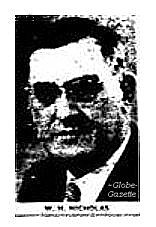 [Section 6, Page 13] In the general election of Nov. 7, 1950, W. H. Nicholas, Mason City turkey raiser
and farmer, was elected Iowa lieutenant-governor. In the following session of the Legislature he presided over the Iowa
Senate.
[Section 6, Page 13] In the general election of Nov. 7, 1950, W. H. Nicholas, Mason City turkey raiser
and farmer, was elected Iowa lieutenant-governor. In the following session of the Legislature he presided over the Iowa
Senate.
While the election of Nicholas had been generally predicted with the expected Republican sweep in November, it
was in the June primary election that he confounded the forecasters by defeating J. Kendall Lynes, Plainfield farmer, and
Richard V. Leo, Dysart, for the party nomination.
Two years later, however, Nicholas' bid for the governorship failed
in a three-cornered race that resulted in the re-election of Gov. William Beardsley. Ken Evans, a former lieutenant-governor,
was the only other candidate.
The entry of Nicholas into state politics followed a term in the Iowa House as
representative from Cerro Gordo County [1947]. Many years [1916-1924] previous he served eight years as recorder of Butler County, at which time
he was a resident of Allison.
Mr. and Mrs. Nicholas who live at 60 Crescent Drive, have three children, a son, Bill, who
is following in the footsteps of his father in operating the turkey business, and two daughters, Idella and Mrs. Edward
Schick.
NOTE: William H. Nicholas, fondly known as "Turkey Bill,"
was born in Butler County, Iowa, October 10, 1892. He served in the
U.S. Navy during World War I. He was Iowa's Lieutenant-Governor from 1951 to 1953, serving under Governor William S.
Beardsley, and a second term from 1957 to 1959, serving under Governor Herschel C. Loveless. He sought the Republican
nomination for Governor three times in the 1950's and 1960's but never received the nomination.
He was a pioneer in
the Iowa turkey business, building the state's first turkey laying house in 1938. He owned and operated
eight chicken hatcheries and at one time his turkey operations produced 100,000 birds annually. He died in Mason City on
August 13, 1984 at the age of 91 years. ~ SOURCE: collguides.lib.uiowa.edu/?MSC0288
Peoples' Gas In Big Expansion Program
The year 1950 marked the virtual completion of a $2,200,000 expansion program which increased the generating
capacity of the Peoples' Gas and Electric by 32 per cent.
A new turbo-generator with 7,500 kilowatt capacity was
installed. This installation produces 180,000 kilowatt hours a day and brought the total generating equipment of the plant
to four turbo-generators capable of producing 650,000 kilowatt hours a day.
A new building addition to the power plant
at 420 Delaware S.E., houses a new 100,000 pounds an hour steam boiler and a new water intake system. The new boiler
has a height of a 6-story building and can be fired by pulverized coal, fuel oil or natural gas, thus providing an
unfailing fuel supply.
With this addition the plant has four boilers, which require 200 tons of coal a day. The new
unit alone can burn 150 tons every 24 hours.
Cooling water from Willow Creek is passed through condensers and returned
at the rate of 21,600,000 gallons a day - more than is used by all the customers of the Mason City Water Works in eight
days.
* * * * * * * * * * * * * * * * * * * * * * * * *
1951: MASON CITYANS SENT INTO SERVICE
[Section 6, Page 14] The big news nationally in 1951 happened on April 11 when President Harry S. Truman
fired Gen. Douglas MacArthur, 71-year-old hero of two wars, who had other ideas of how the Communists in Korea should
be handled.
The action stirred up a bitter controversy throughout the nation - not so much on Truman's right to relieve
a commanding general as on the way it was handled. The result was that Gen. MacArthur, upon his return to this country,
got a hero's welcome that had not been seen since Charles A. Lindbergh flew the ocean 24 years earlier.
In a speech before
a joint session of Congress on April 19, Gen. MacArthur defined his reasons for advocating hitting the enemy behind its
own lines. He ended with the phrase that was to become the most quoted of the year, "old soldiers never die; they just
fade away."
Scores of Mason Cityans wired the President, most of them opposed to his action in dismissing the general.
On Fighting FrontThe Gen. MacArthur dismissal was only one event of the grueling battle going
on in Korea in which Mason City boys, with boys from all parts of the land, were fighting, bleeding and dying.
They have
entered the services by enlistments and through the draft, which started nearly two years before the beginning of the
Korean conflict in June, 1950. Since the registration for the draft in September, 1948, there have been approximately 500
inductees of boys between the ages of 18 and 26 years. Of these nearly 200 are already out of the service again. In the
same period there have been approximately 749 enlistments. Of these some over 200 have returned from the service.
Handling the draft for the county is a board made up of George Dunn, Hines Mount and L. R. Whipple. Those drafted serve
24 months after which they are placed in the reserves. Those inducted and enlisting have gone to Korea, to Germany and to
many other stations throughout the world as well as on ships at sea.
Rebuilt PlantImportant
events at home included the vast plant rebuilding program of the Lehigh Portland Cement Company, of which George
Hannan is the manager. The capacity of the plant was increased from 3,300 barrels to 6,000 barrels daily.
The Northwestern
States Portland Cement Company which sold 2,000 barrels of cement in 1951, continued its program of improvement.
The volume at the Jacob E. Decker and Sons plant showed a 10 per cent increase for the year.
* * * * * * * * * * * * * * * * * * * * * * * * *
GIVEN POSTHUMOUS AWARD
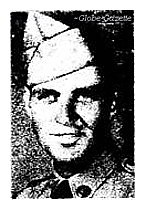
[Section 6, Page 14] Pfc. Charlie R. Alitz of Plymouth was one of the Cerro Gordo County heroes in the
Korean war. He was killed Dec. 2, 1951, while he and his brother, Rolland, who had been inseparable companions
since they were youngsters, were fighting in adjoining foxholes. Henry Alitz, father of the youth, received the silver
star awarded Charles Alitz for gallantry in action.
NOTE: Charles Ray "Charlie" Alitz was born July 12, 1930. He was interred
at Oakwood Cemetery, Plymouth, Iowa.
* * * * * * * * * * * * * * * * * * * * * * * * *
1952: 3 NEW INDUSTRIES HERE
[Section 6, Page 14] When spring came in 1952 it brought not only the beginning of another crop year and
more delightful weather. It brought announcements of important industrial developments in Mason City.
On March 4 the
North Iowa Co-Operative Processing Association revealed it had been granted a priority and allotment of materials for
construction of a $1,500,000 solvent type processing plant and the following April 10 the board of directors authorized
the management to proceed with the erection of the plant on a 20-acre plot on Highway 106 west of the State Brand Creameries,
Inc.
Not long afterwards the construction of [the] factory got under way under the supervision of Manager Glenn Pegeler
and engineers from the R. W. Becker and Associates of St. Louis. Erected were a 350,000 bushel concrete elevator with truck
and carload dumps and a 1,200 bushel per hour grain dryer. Other buildings included an office, boiler plant warehouse
and preparation and extraction building, all of fire-proof construction.
By this spring the plant was completed
and the offices moved from Manly to Mason City. The association had been operating a small compressor type plant at
Manly for several years.
Restored City's Faith
But the spring of 1952 brought two other announcements of industrial developments that served to restore the city's
faith in its future.
On April 10, 1952, the Allied Mills, Inc., of Chicago announced it would start at once on the
construction of a feed manufacturing plant in Mason City and eight days later Swift and Company announced plans
for the construction of an agricultural food factory.
Construction of the Allied Mills plant got under way on a 55-acre
plot a half mile south of the Drive-In Theater west of Mason City between Highways 18 and 106. Harold J. Buist, president
of Allied Mills, said the plant will manufacture Wayne Feeds. He said many new innovations in feed mixing will be
included in the plant, which will have a capacity of 10,000 to 15,000 tons of manufactured feed a month.
It was pointed
out that not only will the plant make use of much labor from this community, but it will also provide a new local outlet
for grains produced in this area.
Construction of the plant got under way and is now practically completed.
Building Swift Plant
Later in the year construction was started on the Swift and Company fertilizer factory at the intersection of the
Chicago & Northwestern and M. and St. L. Railroad tracks south of Mason City on part of the Charles H. Edel farm. The
15-acre site is one mile south of 19th S.E. and a half mile east of Highway 65.
Plant food such as Vigoro for home and
garden use and Brimm Blenn and Red Steer for agricultural use are to be manufactured and distributed throughout Iowa,
Minnesota and the Dakotas.
Another industrial development during the year was the purchase of a 100-acre tract of
land in southwest Mason City by the Milwaukee Road to have available for factory sites.
* * * * * * * * * * * * * * * * * * * * * * * * *
COMPLETES HUGE PAVING PROGRAM
[Section 6, Page 15] Mason City's largest paving program since the city was modernized by Mayor T. A.
Potter back 1916-18, was completed in 1952. More than four miles of streets got concrete paving during the year. Shown
above is the new paving on 12th N.E. looking west toward the Winnebago River bridge.
* * * * * * * * * * * * * * * * * * * * * * * * *
1953: GREATER NORTH IOWA FAIR SEEN
[Section 6, Page 15] As it celebrates its 100th birthday, Mason City in 1953 can look back on a century
that has brought many achievements and impressive monuments to the resourcefulness and sacrifices of its citizens.
The city and county can also look forward to many definite needs such as adequate facilities for an expanding school
population, a courthouse secure against fire, a community auditorium, arterial streets to facilitate the flow of traffic,
additional parks, parkways and recreational facilities.
One of the first big developments in the new century is
expected to be the Greater North Iowa Fair. Supported by the record crowds at the 1952 exposition, the management
is hopeful that the 1953 fair will be the last on the present grounds and that by next year sufficient buildings and other
equipment will be erected on the new grounds west of Mason City for staging the fair there in 1954.
Lawson
Started Drive
 The drive for expansion of the fair began with the selection of M. C. "Cap" Lawson as secretary-manager in 1947, when he
retired as manager of International Harvester Company. The district livestock and agricultural shows in both the junior
and senior divisions were expanded and the premium list materially increased. The premiums paid at the 1952 fair reached
a total of $18,000, a new high record.
The drive for expansion of the fair began with the selection of M. C. "Cap" Lawson as secretary-manager in 1947, when he
retired as manager of International Harvester Company. The district livestock and agricultural shows in both the junior
and senior divisions were expanded and the premium list materially increased. The premiums paid at the 1952 fair reached
a total of $18,000, a new high record.
At the last annual meeting of the fair association it was reported that $30,000
had been paid on the 80-acre tract of the new site and $1,000 on the adjoining 40 acres and that the association had more
than enough funds on hand to pay the remaining $16,200 due on the entire 120 acres.
Courthouse Big Need
With the passage of the $1,200,00
bond issue at the last general election for the erection of two new grade schools, Mason City's school building needs
have been provided for the immediate future.
The most crying need at the moment is a safe courthouse, about which
much has previously been written. The existing building, unsafe both for human occupants and the records, is not
the type of structure that Cerro Gordo County residents will tolerate indefinitely.
* * * * * * * * * * * * * * * * * * * * * * * * *
BUILT MASON CITY PLANT

[Section 6, Page 15] Walter J. Maytham brought to a close a distinguished career as chief engineer
of the Northwestern States Portland Cement Company plant in Mason City upon his retirement on Jan. 1, 1953. It was he
who drew the plans for and superintended the construction of this plant.
* * * * * * * * * * * * * * * * * * * * * * * * *
CITY MANAGER FORM ABANDONED in 1944 for COUNCIL PLAN
[Section 6, Page 15] On Jan. 21, 1944, the city voted 2,615 to 2,480 to abandon the city manager form
of government, which it had adopted in 1927. In its place came the mayor and council government.
At the election on
March 26, 1945, an Associated Citizens ticket backed by citizens interested in sound city government, was elected,
consisting of Mayor Howard E. Bruce, recently retired as manager of Mason City division of Standard Oil; S. W. Lock,
Adrian Hart, Dr. H. H. Jennings, Henry Rheingans, Emil Koerber, Fred Steffen. In March, 1946, Hart resigned and was
replaced by E. J. Kelly. The group was re-elected in 1947.
Under Mayor Bruce's leadership the city government has
maintained the general pattern of operation set up under the council-manager form.
* * * * * * * * * * * * * * * * * * * * * * * * *
BRICK AND TILE MANAGER
 [Section 6, Page 15]
[Section 6, Page 15]
A. C. Frisk has been general manager of the Mason City Brick and Tile Company since 1947. Previous to that
he was for several years sales manager of the company, with which he has been identified for 25 years.
* * * * * * * * * * * * * * * * * * * * * * * * *
LEHIGH MANAGER

[Section 6, Page 15] Since August in 1951, George Hannaman has been manager of the Mason City plant of
the Lehigh Portland Cement Company. He succeeded Arnold J. Johnson, another native Mason Cityan, who was transferred
to the home office of the company at Allentown, Pa.
NOTE: George W. Hannaman was born
January 2, 1913, and died May 6, 1970, interment was made at Memorial Park Cemetery.
* * * * * * * * * * * * * * * * * * * * * * * * *
1923: DECKER GENERAL MANAGER
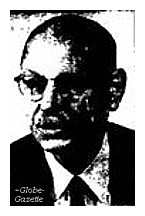
[Section 6, Page 15] General manager of Jacob E. Decker and Sons, Mason City's large meat packing
plant, is Preben Thogerson. He was appointed to this position in 1943 to succeed Fred G. Duffield. Thorgerson came up
through the ranks of the Decker plant.
* * * * * * * * * * * * * * * * * * * * * * * * *
SUGAR PLANT MANAGER
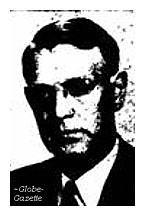
[Section 6, Page 15] A. G. Quammo came to Mason City in 1938 as agricultural superintendent of the
American Crystal Sugar Company. The following year he succeeded E. C. Moore as general manager of the plant, which
position he has held since.
* * * * * * * * * * * * * * * * * * * * * * * * *
SINCE MASON CITY WAS 16 YEARS OLD
[Section 6, Page 16]
These First National Bank Leaders, 1869 to 1953, Have Had An Active Part
In The Business,
Industrial and Social Development of This Community.This always dependable, always constructive,
always forward-looking bank
has been an important factor in the development of Mason City and vicinity.
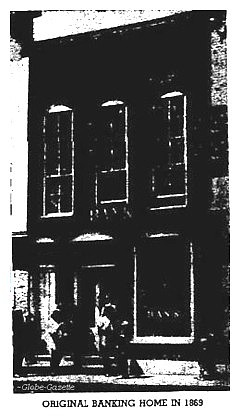
WHEN THIS BANK WAS
ESTABLISHED IN 1869
President U. S. Grant Was Inaugurated
Schuyler Colfax Was Vice President
Iowa Governor - Samuel Merrill of Clayton County
1868 to 1872
Iowa Lieutenant Governor - John Scott of Story County
1868 to 1870
The First Railroad Here Was Just Laying
Its Rails Into Mason City
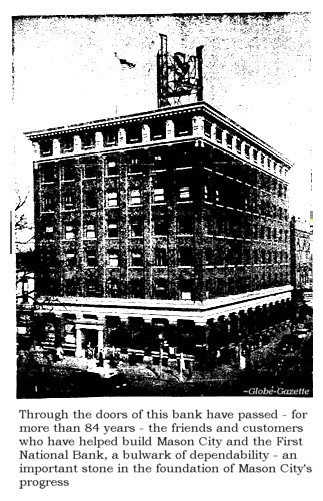
WE hope to see YOU at Mason City's Centennial
Homecoming and Band Festival
celebration . . . June 7 to 14.
Come and have a good time!
First National Bank
MASON CITY, IOWA A GOOD BANK TO TIE TO FOUNDED IN 1869
* * * * * * * * * * * * * * * * * * * * * * * * *
Unless otherwise noted, photographs courtesy of The Globe-Gazette.
Some of the photographs did not scan well. In such a case the photograph has
been substituted with a clearer copy if available.
Transcriptions and Notes by Sharon R. Becker, December of 2014
Information obtained in notes from cemetery transcriptions, obituaries,
biographies & other Globe-Gazette articles


